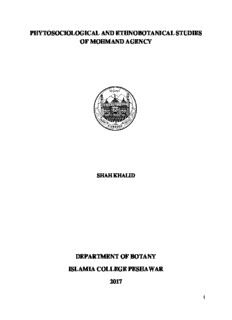
phytosociological and ethnobotanical studies of mohmand agency department of botany islamia PDF
Preview phytosociological and ethnobotanical studies of mohmand agency department of botany islamia
PHYTOSOCIOLOGICAL AND ETHNOBOTANICAL STUDIES OF MOHMAND AGENCY SHAH KHALID DEPARTMENT OF BOTANY ISLAMIA COLLEGE PESHAWAR 2017 i PHYTOSOCIOLOGICAL AND ETHNOBOTANICAL STUDIES OF MOHMAND AGENCY Thesis submitted to the Department of Botany, Islamia College Peshawar, in partial fulfillment of the requirements for the award of degree of DOCTOR OF PHILOSOPHY IN BOTANY By SHAH KHALID DEPARTMENT OF BOTANY ISLAMIA COLLEGE PESHAWAR 2017 ii iii iv v To my Parents And My Mentor Prof. Dr. Syed Zahir Shah vi Table of Contents TABLE OF CONTENTS…………………………………………………………………………I LIST OF TABLES ......................................................................................................................... vi LIST OF FIGURES ...................................................................................................................... vii LIST OF ABBREVIATIONS ...................................................................................................... viii ACKNOWLEDGEMENTS ............................................................................................................ x ABSTRACT .................................................................................................................................... 1 CHAPTER 1 ................................................................................................................................... 3 1. INTRODUCTION ................................................................................................................... 3 1.1. General objectives ................................................................................................................. 3 1.2. Site Description ..................................................................................................................... 3 1.2.1. Boundary and Locality ................................................................................................... 3 1.2.2. Administration ................................................................................................................ 4 1.2.3. People of Mohmand Agency .......................................................................................... 5 1.2.4. Demography ................................................................................................................... 6 1.2.5. Physiography .................................................................................................................. 6 1.2.6. Climate ........................................................................................................................... 7 1.2.7. Education ........................................................................................................................ 7 1.2.8. Agriculture ..................................................................................................................... 8 1.2.9. Forests ............................................................................................................................ 9 1.3. Scope of the Study Area .................................................................................................... 9 1.4. Introduction to Phytosociology ........................................................................................... 12 1.4.1. History and Scope of Phytosociology .......................................................................... 13 1.4.1.1. Dependent Unions ................................................................................................. 13 1.4.1.2. Commensal Unions................................................................................................ 14 1.4.2. Classification of Plant Communities ............................................................................ 14 1.4.3. Life Form: An Important Character in Plant Sociology ............................................... 14 1.4.4. Properties of Communities for Identification............................................................... 17 1.4.4.1. Species Richness.................................................................................................... 17 i 1.4.4.2. Species Diversity ................................................................................................... 18 1.4.4.3. Species Abundance ................................................................................................ 18 1.4.5. Factors Shaping the Plant Communities ...................................................................... 18 1.4.6. Analyses of Plant Communities ................................................................................... 19 1.4.7. Importance of Phytosociology ..................................................................................... 20 1.5. The Science of Survival: Ethnobotany ............................................................................... 35 1.5.1. Different Uses of Plants ............................................................................................... 37 1.5.2. Why Ethnobotany Is Important .................................................................................... 37 1.6. Conservation of Flora ......................................................................................................... 46 CHAPTER 2 ................................................................................................................................. 50 2. METHODOLOGY ................................................................................................................ 50 2.1. Phytosociology .................................................................................................................... 50 2.1.1. Reconnaissance ............................................................................................................ 50 2.1.2. Primary Survey ............................................................................................................. 50 2.1.3. Extensive Survey .......................................................................................................... 51 2.1.4. Method for Sampling ................................................................................................... 51 2.1.5. Community Attributes That Were Studied................................................................... 51 2.1.5.1. Importance Value (IV) ........................................................................................... 51 2.1.5.2. Similarity Index (SI) .............................................................................................. 52 2.1.5.3. Species Diversity (SD) .......................................................................................... 52 2.1.5.4. Species Richness (SR) ........................................................................................... 52 2.1.5.5. Maturity Index ....................................................................................................... 53 2.1.5.6. Life Form ............................................................................................................... 53 2.1.5.7. Leaf Size Spectra ................................................................................................... 54 2.1.5.8. Leaf Types ............................................................................................................. 54 2.1.5.9. Phenological Behavior ........................................................................................... 54 2.2. Ethnobotany ........................................................................................................................ 55 2.2.1. Data Collection ............................................................................................................. 55 2.2.1.1. Relative Frequency Citation .................................................................................. 56 2.2.1.2. Use Value (UV) ..................................................................................................... 56 2.2.1.3. Relative Importance ............................................................................................... 56 ii 2.2.1.4. Pearson Product-Moment Correlation Coefficient ................................................ 57 2.3. Palatability .......................................................................................................................... 57 2.4. Measurement of Rangeland Productivity ............................................................................ 57 2.5. Nutritional and Chemical Analysis of Some Selected Plants ............................................. 57 2.6. Edaphology ......................................................................................................................... 58 2.7. Conservation Status of the Flora ......................................................................................... 58 2.8. Data Analysis ...................................................................................................................... 59 CHAPTER 3 ................................................................................................................................. 60 3. RESULTS AND DISCUSSION ............................................................................................ 60 3.1. Floristics .............................................................................................................................. 60 3.1.1. Life Form and Its Seasonality ...................................................................................... 62 3.1.2. Leaf Size Spectra and Its Seasonality .......................................................................... 63 3.2. Phenology ........................................................................................................................... 78 3.3. Community Structure .......................................................................................................... 94 3.3.1. Spring Aspect .............................................................................................................. 95 3.3.1.1. Artemisia-Brachypodium-Aristida Community (AMB) ........................................ 95 3.3.1.2. Dodonaea-Brachypodium-Hordeum Community (DSK) ..................................... 95 3.3.1.3. Hordeum-Medicago-Peganum Community (KJK) ............................................... 96 3.3.1.4. Bromus-Trigonella-Silene Community (LSP) ....................................................... 97 3.3.1.5. Aristida-Hordeum-Phalaris Community (KTP) ................................................... 97 3.3.1.6. Dodonaea-Rumex-Acacia Community (PRG) ...................................................... 98 3.3.1.7. Hordeum-Medicago-Peganum Community (KJK) ............................................... 99 3.3.1.8. Brachypodium-Astragalus-Teucrium Community (SAF) ..................................... 99 3.3.1.9. Medicago-Acacia-Acacia Community (TRG) ..................................................... 100 3.3.1.10. Hordeum-Malcolmia-Rhazya Community (YKG) ............................................ 100 3.3.2. Summer Aspect ......................................................................................................... 101 3.3.2.1. Artemisia-Brachypodium-Aristida Community (AMB) ...................................... 101 3.3.2.2. Dodonaea-Brachypodium-Hordeum Community (DSK) ................................... 102 3.3.2.3. Hordeum-Medicago-Peganum Community (KJK) ............................................. 102 3.3.2.4. Aristida-Hordeum-Phalaris Community (KTP) ................................................. 103 3.3.2.5. Bromus-Trigonella-Monotheca Community (LSP) ............................................. 103 iii 3.3.2.6. Dodonaea-Acacia-Mentha Community (PRG) ................................................... 104 3.3.2.7. Hordeum-Medicago-Peganum Community (KRP) ............................................. 104 3.3.2.8. Brachypodium-Astragalus-Teucrium Community (SAF) ................................... 105 3.3.2.9. Medicago-Acacia-Acacia Community (TRG) ..................................................... 106 3.3.2.10. Hordeum-Malcolmia-Rhazya Community (YKG) ............................................ 106 3.3.3. Winter Aspect ........................................................................................................... 107 3.3.3.1. Artemisia-Acacia-Malcolmia Community (AMB) .............................................. 107 3.3.3.2. Dodonaea-Medicago-Alyssum Community (DSK) ............................................. 108 3.3.3.3. Medicago-Herneraria-Filago Community (KJK)............................................... 108 3.3.3.4. Medicago-Acacia-Trigonella Community (KRP) ............................................... 109 3.3.3.5. Malcolmia-Polygonum-Dodonaea Community (KTP) ....................................... 110 3.3.3.6. Bromus-Trigonella-Monotheca Community (LSP) ............................................. 110 3.3.3.7. Dodonaea-Rumex-Acacia Community (PRG) .................................................... 111 3.3.3.8. Teucrium-Cynodon-Acacia Community (SAF)................................................... 111 3.3.3.9. Medicago-Acacia-Acacia Community (TRG) ..................................................... 112 3.3.3.10. Malcolmia-Rhazya-Medicago Community (YKG) ........................................... 112 3.3.4. Autumn Aspect ......................................................................................................... 113 3.3.4.1. Acacia-Salvia-Aristida Community (AMB) ........................................................ 113 3.3.4.2. Dodonaea-Aristida-Acacia Community (DSK) .................................................. 114 3.3.4.3. Monotheca-Rhazya-Acacia Community (KJK)................................................... 114 3.3.4.4. Acacia-Withania-Ziziphus Community (KRP) .................................................... 115 3.3.4.5. Polygonum-Dodonaea-Withania Community (KTP) .......................................... 115 3.3.4.6. Monotheca-Salvia-Rhazya Community (LSP) .................................................... 116 3.3.4.7. Dodonaea-Acacia-Acacia Community (PRG) .................................................... 116 3.3.4.8. Astragalus-Teucrium-Acacia Community (SAF) ................................................ 117 3.3.4.9. Acacia-Acacia-Tribulus Community (TRG) ....................................................... 117 3.3.4.10. Rhazya-Ziziphus-Acacia Community (YKG) .................................................... 118 3.3.5. Discussion .................................................................................................................. 118 3.3.5.1. Community Structure .......................................................................................... 118 3.3.6. Diversity Indices ....................................................................................................... 119 3.3.7. Species Richness ....................................................................................................... 121 iv
Description: